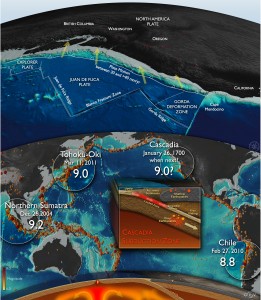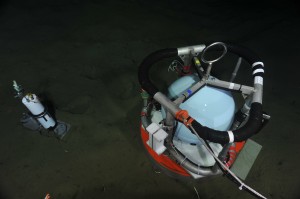
When will the next great earthquake occur in the Pacific Northwest? (figure created by the Center for Environmental Visualization)
The devastating earthquakes off Sumatra, Chile and Japan have raised awareness of the inevitability of a comparable earthquake along the coast of the Pacific Northwest. Within the Pacific Northwest considerable efforts have been devoted to expanding seismic and GPS networks on land, conducting extensive offshore experiments with autonomous ocean bottom seismometers and installing cabled observatories. Relatively little attention has been paid until recently to seafloor geodesy despite its importance for understanding the basic science and hazard of the Cascadia subduction zone. In particular most of the locked zone that will fail in a megathrust earthquake lies offshore in Cascadia; its offshore extent and along strike variations not well constrained by land observations.
In 2012 I helped convene a workshop on Seafloor Geodesy in Cascadia at the UW. This workshop recommended that “the initial objectives of seafloor geodesy should be to address scientific questions related to measuring and understanding: (1) The motion and deformation of the Juan de Fuca plate, (2) the spatial extent of the locked zone of the megathrust and whether some segments of the subduction zone are creeping, and (3) the characteristics of offshore transient deformation events. The long-term objective should be real-time monitoring along the entire length of the subduction zone. This would serve the dual purposes of providing long-term scientific seismic and geodetic observations and supporting earthquake and tsunami warning systems.”
Recently I have started collaborating with Mark Zumberge and Glen Sasagawa at the Scripps Institution of Oceanography and new faculty member Emily Roland in the School of Oceanography on a project to build and test an absolute seafloor calibrated pressure recorder (ASCPR). This device is transported with a remotely operated vehicle and uses a dead weight tester to obtain campaign style absolute pressure measurements on seafloor benchmarks. The ASCPR will provide a means to remove the drift from continuously recording of pressure gauges and thus make it feasible to observe seafloor elevation changes associated with secular strain (i.e., plate locking).

